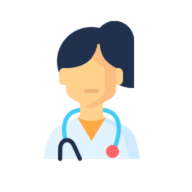
Quick Links
Resources
About MyLeukemiaTeam
Powered By






Chronic lymphocytic leukemia (CLL) is a slow-growing type of blood cancer. It often doesn’t cause symptoms right away — even when signs of the condition.
Many people use the terms “symptoms” and “signs” to mean the same thing, but they have different meanings. A symptom is something you feel or experience internally, like nausea or pain. On the other hand, a sign is something that can be observed or measured by a doctor, like a fever or a rash. Many times, signs and symptoms are closely linked.
If you notice any signs or symptoms that could be related to CLL, talk to your doctor as soon as you can. Your doctor can help you understand the cause and guide you toward the right care.
About 50 percent to 75 percent of people with CLL don’t have symptoms when they’re first diagnosed. Symptoms often appear later as CLL gets worse.
Tiredness caused by CLL is sometimes called cancer-related fatigue. This type of exhaustion can affect you physically, mentally, or emotionally. Unlike regular tiredness, it doesn’t get better with sleep and rest.
Shortness of breath related to CLL may start suddenly or get worse over time. You might feel out of breath after finishing a task that used to be easy for you. If shortness of breath lasts more than one month, especially with a persistent cough, it could be a symptom of CLL.

B symptoms are systemic (whole-body) symptoms that occur without another obvious cause, such as infection. They can be a sign of disease progression and may signal the need to start CLL treatment.
B symptoms associated with CLL include:
Malaise — or general discomfort — can also occur in people living with CLL. This general, overall feeling of unease or illness can be another telltale symptom when paired with other common symptoms of CLL.
People with CLL may sometimes feel full or experience pain in the stomach area. This feeling often occurs after eating only a small amount of food. This is often caused by enlarged organs, such as the spleen or liver.
These symptoms can also be caused by other health conditions besides CLL. If you’re experiencing any of them, your doctor will ask questions and may run tests to determine the cause.
Signs of chronic lymphocytic leukemia (CLL) refer to measurable changes that can be detected by a doctor or through medical tests. Often, CLL is diagnosed incidentally during routine blood work before symptoms appear.
The first sign of CLL is often lymphocytosis (high levels of white blood cells). A doctor may see this unusual result after running blood tests during a routine checkup or while doing tests related to a different health concern. High white blood cell counts can be a sign that those white blood cells are abnormal and are not working properly.
People with CLL often have low levels of healthy blood cells. This happens because leukemia cells build up in the bone marrow — the spongy tissue inside bones where new blood cells are made. As these cancerous cells multiply, they crowd out normal blood-forming cells, leading to fewer healthy white blood cells, red blood cells, and platelets.

Additionally, CLL can weaken the immune system. Normally, immune cells produce antibodies — proteins that help fight infection. However, in CLL, immune cells sometimes make abnormal antibodies that kill the body’s healthy blood cells. This also can lead to low blood cell counts, a common sign of CLL.
People with CLL often have low levels of healthy white blood cells, a condition called leukopenia. If they have very low levels of a type of white blood cell called neutrophils, it’s called neutropenia. Neutropenia is more likely to occur during treatment as a side effect of chemotherapy.
White blood cells help the body fight infections. In CLL, there are too many abnormal white blood cells, but these cells don’t work properly. At the same time, there are fewer healthy white blood cells, making it harder for the body to fight infections.
People with CLL are at risk for many types of infections, including bacterial infections (such as pneumonia, skin infections, or sinus infections) and viral infections (such as the flu, COVID-19, or reactivated herpes viruses, like shingles). Both bacterial and viral infections can become serious if not treated.
Signs and symptoms of an infection may include:
Many people with CLL develop anemia — low red blood cell counts. Red blood cells carry oxygen to tissues throughout the body. Without enough red blood cells, people may experience symptoms like fatigue, weakness, dizziness, shortness of breath, or an irregular heartbeat.
Thrombocytopenia — low levels of platelets — is another sign of CLL. Platelets are small pieces of cell that help blood clot after an injury. People with thrombocytopenia may bruise easily and have bleeding problems, such as nosebleeds, bleeding gums, or heavy menstrual periods.
During later stages of CLL, as the disease gets worse, some people may develop splenomegaly — an enlarged spleen. The spleen is an organ in the abdomen that removes old blood cells and stores an extra supply of healthy blood cells. When the spleen grows larger, it can cause additional symptoms. People may feel pain in the left, upper part of the abdomen, or feel full after only eating a little.
In advanced stages of CLL, enlarged lymph nodes may occur. Lymph nodes are small, bean-shaped glands found throughout the body. They are part of the immune system and help filter harmful substances and fight infections. Swollen lymph nodes feel like hard lumps that may grow larger over time. People often first notice swollen lymph nodes in the armpits, neck, or groin.
Treatments for chronic lymphocytic leukemia can cause additional health problems, some of which may mimic or worsen both signs and symptoms of the disease. People undergoing treatment for CLL may experience:
Different treatment options for chronic lymphocytic leukemia come with different side effects. Chemotherapy drugs often cause more severe side effects. Targeted therapy drugs — such as kinase inhibitors and monoclonal antibodies — tend to be milder but can still lead to serious complications. Talk to your doctor to understand the potential side effects of your specific treatment plan.
The health problems caused by CLL and its treatments can be managed with palliative care. This type of care is often part of an active CLL treatment plan to help relieve symptoms and improve quality of life.
Palliative care focuses on treating the signs and symptoms of chronic illnesses like cancer. Though sometimes confused with hospice (end-of-life) care, palliative care can be provided at any stage of the disease, regardless of prognosis.
A palliative care team offers emotional, practical, and spiritual support while helping to manage leukemia symptoms and treatment side effects. If you’re interested in palliative care, talk to your cancer care team to learn more.
MyLeukemiaTeam is the social network for people with leukemia and their loved ones. On MyLeukemiaTeam, more than 20,000 members come together to ask questions, give advice, and share their stories with others who understand life with leukemia.
Are you living with chronic lymphocytic leukemia? Share your experiences in the comments below, or start a conversation by posting on your Activities page.
I Have Been Feeling Sick Since Before Christmas, I Think Even Around Thanksgiving. I Have Cold Systems After Christmas I Had Covid, Then I
Sign up for free!
Become a member to get even more




A MyLeukemiaTeam Member
I think that this article was very informative and easy to understand. I was diagnosed in 2015 with CLL and since then have had a number of surgeries and radiation treatments.The article helped to… read more